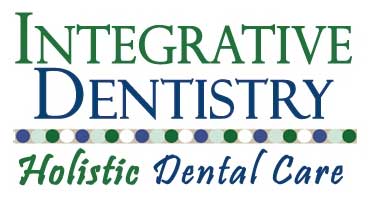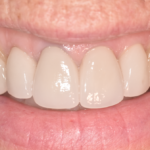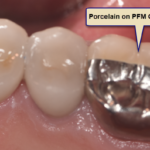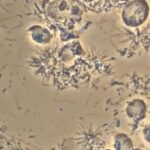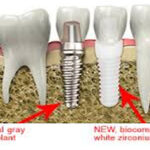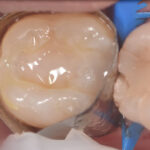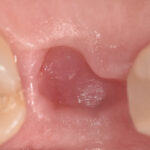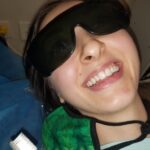The bones of the human head are directly associated with two of the body’s most complicated joint systems, the cranial sutures of the skull and the TMJ (temporal mandibular joint). The human head sits atop the cervical structure with the center of gravity in front of the spine, linked by the musculature and joints. The function of the head posture when moving or at rest is dependent on the proper alignment of these muscles and joints. Depending on the degree, misalignment of any of these muscles or joints can translate into further stresses elsewhere in the structure.
Often the most troublesome chiropractic cases are very simple dental orthopedic cases and even the most persistent and skilful chiropractic adjustments will simply not hold when the surfaces of the bite do not line up correctly. The adult human has 32 teeth including four wisdom teeth and each one of these teeth has from 5 to 7 surfaces. When any one of these surfaces is compromised in any way, the effects- though subtle at first- may be felt throughout the structure, particularly the musculature. One reason for this is the force involved with chewing, since the bite sustains up to 200 lbs of pressure several times a day.
Teeth can become loose, broken or worn down. This can be caused by the body’s attempts to compensate for a misaligned bite or the aggravation of clenching (bruxing) and grinding. These latter are stress responses to nervous tension that are most often found among women. Of the 20% of the United States population, mostly in their thirties and forties, who are suffering from TMJ Disorder, four times as many women as men are affected.
The TMJ is the most active joint in the body, in motion up to 2,000 times every day. We use this joint in breathing, chewing, swallowing and speaking. In addition it directs the postural relationships of the head, neck, tongue, chin and hyoid, a small bone in the neck that supports the tongue. It is the only joint in the body that acts as a two-sided hinge. This means that any stress or misalignment on one side will reflect a disturbance on the other side.
The painful aspects of TMJ dysfunction or TMD, occur because of its association with the tri-geminal nerve. There are three branches of the nerve that are involved with the chewing function of the upper and lower jaw, and with the eyes and ears. There are two groups of pain receptors, one which transmits pain quickly and the other type which is more susceptible to chronic, dull, pain and pressure. Both types of pain fibers have input to the spine.
Other areas connected to the trigeminal nerve are the sinuses, ear canal, oral cavity and teeth. This helps to explain why headaches, eye pain, sinus pressure, dental pain and even neck and shoulder pain can be caused by TMJ dysfunction. The trigeminal nerve is also involved with the reticular activating system, part of the brain stem. It affects many functions of the cerebral cortex of the brain that maintain our states of consciousness, including our emotional states. This can help to explain the highly emotional component of facial pain.
Among the ten symptoms of TMJ Disorder are:
- Clicking & popping of the TMJ joint caused by lack of cartilage at the rear hinge point.
- Grinding sounds caused by irregular bone surface at rear hinge point.
- Headaches and migraine headache caused by pressure of ball (condyle) of joint pushing on weak bone structure at rear of joint.
- Dizziness caused by lack of blood flow to brain when blood vessels are obstructed.
- Ringing in the ears caused by pressure on the ear canal.
- Excessive wear on teeth caused by stress of bruxing and grinding.
- Severe pain all over head caused pinching of nerves due to extreme misalignment of TMJ.
- Pain in neck generally caused by stress on muscles due to misaligned bite.
- Earache caused by pressure on the ear canal.
- Sensitivity to light due to tri-geminal nerve connection with the eyes.
It is possible to have TMJ dysfunction for a long time without realizing it since often the symptoms, such as some of those above, seem unrelated to your jaw joint. At our practice we use an inter-disciplinary healthcare model that focuses on the connection between the physiological and structural integrity of the bite with that of the structure as a whole. It is especially useful in the treatment of conditions like TMJ dysfunction, arthritic conditions of the neck and headaches.
This multi-faceted approach includes dental corrections such as splint therapy, as well as minute, subtle bite adjustments and muscular release. The dental appointment is coordinated with chiropractic adjustments at a local facility on the same day. The patient then returns to our office so that the mouth and the rest of the system can be re-balanced with reference to one another. This system creates a remarkable depth of structural integrity that can be further enhanced when necessary by the use of a splint to maintain the posture of the jaw.
At times the pain relief brought about by this comprehensive alignment can be almost immediate. This can be wonderful news for patients who have been treated for years for migraine headache pain and have typically spent tens of thousands of dollars on MRI studies, drugs and other therapy with little or no improvement. The patient returns for follow up visits for three to six months or up to one year depending on the complexity of the case. Nutritional supplements and stress management techniques are utilized in certain instances as well.
Dr. Carey O’Rielly is a holistic dentist in San Diego, California who truly understands and practices the tenets of holistic health, both as a practitioner and in his personal life. His remarkable knowledge of the field came about through years of study and experience, initiated by his own work-related health challenges.
